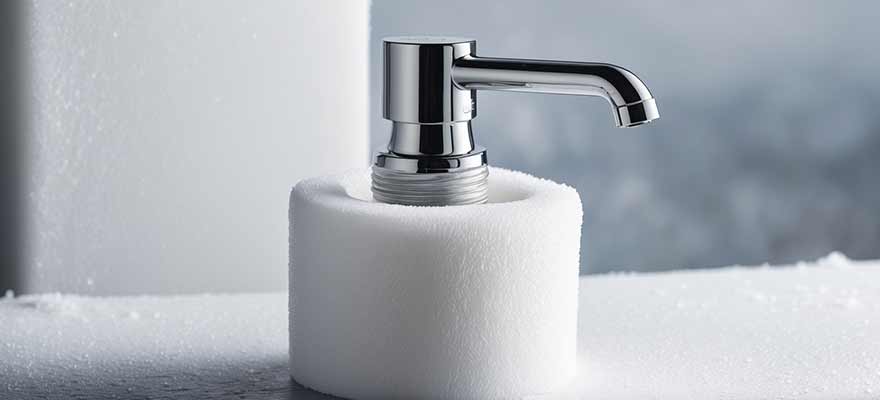When temperatures drop, outdoor faucets are among the most vulnerable parts of your home’s plumbing system. If not properly protected, freezing temperatures can cause water inside these faucets and pipes to expand, leading to costly bursts and water damage. Fortunately, several effective steps can be taken to safeguard your outdoor faucets from freezing and avoid these problems.
In this guide, the local plumbers at Tip Top Plumbing & Restoration provide the most efficient ways to protect your faucets and ensure your plumbing system stays intact through the coldest months.
The Dangers of Leaving Outdoor Faucets Exposed to the Cold
Leaving outdoor faucets exposed during freezing temperatures can lead to various issues, including:
- Burst Pipes: When water freezes, it expands, putting immense pressure on the pipes and causing them to crack or burst. This can lead to significant plumbing emergencies like water damage.
- Flooding: A burst pipe can quickly cause flooding around your home, leading to expensive repairs to your plumbing and property.
- Mold Growth: If a burst pipe isn’t addressed quickly, the resulting moisture can lead to mold growth, which can cause health problems and require costly remediation.
- High Repair Costs: Fixing a burst pipe, cleaning water damage, and addressing related issues can be expensive. Proper protection of outdoor faucets can prevent these problems.

5 Steps to Prevent Outdoor Faucets from Freezing
1. Disconnect Hoses and Drain Water
Before temperatures drop, always disconnect garden hoses from outdoor faucets. Water trapped in the hose can freeze and return to the faucet, leading to frozen pipes. Additionally, drain any remaining water from the faucet to prevent freezing inside the fixture.
2. Use Faucet Covers or Foam Insulation
Faucet covers, or foam insulation, provide an easy way to prevent freezing. These covers act as barriers, keeping cold air out and protecting the water inside from freezing. Simply secure them over the faucet to reduce the risk of pipe bursts during cold weather.
3. Install a Frost-Proof Faucet
Installing a frost-proof faucet is a long-term solution to prevent outdoor faucets from freezing. These faucets keep the water supply inside your home away from the cold air. This setup significantly reduces the risk of freezing, making it an excellent investment for protecting your plumbing in cold weather. If you experience regular cold snaps, switching to frost-proof faucets can provide peace of mind and save you from costly repairs.
4. Shut Off and Drain Outdoor Water Lines
One of the most effective ways to prevent freezing is to turn off the water supply to your outdoor faucets before freezing temperatures hit. After shutting off the water from the indoor shut-off valve, open the outdoor faucet to drain any remaining water from the lines. This simple step ensures no water is left in the pipes to freeze and expand, reducing the risk of burst pipes and costly repairs.
5. Wrap Exposed Pipes with Heat Tape
Heat tape is an electric heating cable you can wrap around exposed pipes and faucets. It keeps the pipes warm, preventing freezing during cold spells. This method is particularly useful for areas with extended periods of freezing temperatures. Heat tape is easy to install and can be used alongside insulation for protection. Just be sure to follow the manufacturer’s instructions for safe use.
Prepare Your Outdoor Faucets for Winter
Taking steps to protect your outdoor faucets from freezing can help you avoid the frustration of burst pipes, water damage, and costly repairs. By following these simple faucet winterization steps, you can ensure your plumbing remains intact during cold weather.
Don’t wait for freezing temperatures to put your outdoor faucets at risk. Follow these winterization steps now to ensure your plumbing stays safe all season long. If you’re unsure about how to protect your faucets or need professional assistance, Tip Top Plumbing & Restoration is here to help.
Why Choose Us?
- Licensed, insured, and experienced plumbers
- Fast, reliable service to prevent costly plumbing issues
- Emergency plumbers available 24/7
- Comprehensive solutions for outdoor faucet and pipe protection
Whether you need help installing faucet covers, wrapping pipes with heat tape, or upgrading to frost-proof fixtures, we have the expertise to handle it all.
Call Tip Top Plumbing & Restoration today! Contact us at (954) 289-3110 to schedule an inspection or winterization service. Protect your plumbing and enjoy a worry-free winter with the experts you can trust!
FAQs
Should outside faucets be left open or closed in winter?
Outside faucets should be closed after the water supply is turned off and drained. This helps prevent any remaining water from freezing and expanding inside the pipes.
How to tell if an outside faucet is frozen?
If an outside faucet is frozen, you may notice no water coming out when the tap is turned on or see frost or ice buildup around the faucet or pipe.
What happens when outside pipes freeze?
When outside pipes freeze, the water inside expands, causing them to crack or burst. Once the ice thaws, this often leads to leaks and costly water damage.
At what outside temperature do pipes freeze?
Pipes can begin to freeze when the outside temperature drops to 32°F or below, especially if the pipes are uninsulated or exposed to cold air.